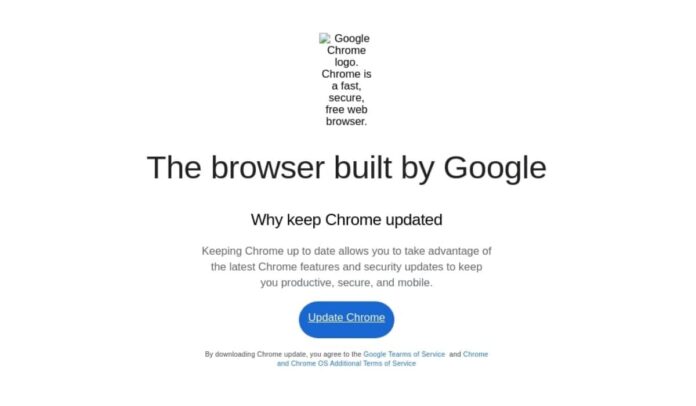[ad_1]
- Fake Chrome Browser Update Scam: Trellix exposes a scheme using fake Chrome browser updates to sneak NetSupport Manager onto victim computers, granting cybercriminals control and data access.
- Possible SocGholish Link: While resembling SocGholish, differences in tools raise doubt about a direct connection, highlighting evolving tactics.
- Compromised Sites as Launchpads: Compromised websites act as launchpads for the attack, affecting diverse sectors, including government and finance.
- Deceptive Path to RAT: Victims fall for the fake update, unknowingly downloading a malicious JavaScript file, “Browser_portable.js,” which activates NetSupport Manager.
- Urgent Need for Vigilance: Trellix’s discovery underscores the critical importance of global threat intelligence and advanced security solutions in countering evolving cyber threats.
Cybersecurity firm Trellix has identified a new cyber campaign exploiting unsuspecting victims by disguising itself as a legitimate Chrome browser update. The deceptive scheme employs a malicious remote administration tool (RAT) known as NetSupport Manager RAT, allowing threat actors to gain unauthorized access to victims’ computers and seize control.
Moreover, the Trellix Advanced Research Center uncovered striking similarities to a previously reported SocGholish campaign, although a definitive connection remains elusive. Yet, concrete links between the two campaigns remain scarce.
The campaign, which came to light in late June 2023, exploits compromised websites as a platform for delivering the fraudulent Chrome update. Victims are lured into downloading and installing the fake update, unwittingly inviting the NetSupport Manager RAT onto their systems. The malware allows cybercriminals to pilfer sensitive information and manipulate victim computers to their advantage.
The modus operandi of the campaign involves injecting compromised websites with a carefully crafted HTML script tag that retrieves JavaScript content from the attackers’ command and control server.
This technique, seemingly automated, hinges on the unsuspecting victims falling for the fake browser update ruse. The success of the scheme relies heavily on the prevalence of compromised websites.
Trellix researchers found evidence of this campaign infiltrating a Chamber of Commerce website, with traffic from governmental entities, financial institutions, and consulting services. Although the site has since been cleansed of the injected script, it suffered compromise for at least one day.
The deceptive journey commences when victims encounter the injected script on a compromised website, leading them to a fake browser update page. This manipulation, which directs users to unwittingly install the NetSupport RAT, isn’t novel; similar tactics have been documented in past instances like the SocGholish campaign.
However, it’s the tools employed in the present campaign that stand apart from SocGholish. SocGholish exploited PowerShell with WMI capabilities to facilitate RAT download and installation. In contrast, the current campaign utilizes batch files (.BAT), VB scripts, and the Curl tool to carry out its malevolent operations. The use of these distinct tools underscores the evolving strategies of cybercriminals.
Should a victim succumb to the allure of the fake browser update and click on the “Update Chrome” link, a ZIP archive named “UpdateInstall.zip” containing a malevolent JavaScript file, “Browser_portable.js,” is initiated for download. This script serves as a downloader for the ensuing stage of the attack.
Upon extraction of the NetSupport Manager RAT via the downloaded 7-zip utility, execution transpires via a scheduled task, orchestrated by the “2.bat” batch file. Furthermore, this batch file also engenders persistence for the RAT, ensuring automatic execution upon system startup.
The malevolent configuration file (“client32.ini”) for the RAT reveals a gateway address set to 5.252.178.48. At this juncture, with the RAT firmly entrenched within the victim’s system, threat actors possess substantial control, enabling them to execute further malware deployment, data exfiltration, network reconnaissance, and lateral movement.
In conclusion, this campaign serves as a reminder that threat actors consistently exploit successful techniques to advance their malicious agendas. The deployment of familiar lures, such as the phony browser update, underscores the persistent nature of these attacks.
The proliferation of RATs, while not always updated, showcases their enduring utility for cybercriminals. As attackers adopt increasingly sophisticated tactics, the challenge of detection intensifies. The utilization of native Windows scripting languages, like VBScript and Batch script, combined with tools like Curl, exemplifies their adaptability and innovation.
Joseph Tal, Senior Vice President of Trellix’s Advanced Research Center, cautioned that the prevalence of these NetSupport RAT attacks underscores the need for comprehensive global threat intelligence and innovative security solutions.
Commenting on this, Dr Klaus Schenk, senior vice president, Security and Threat Research at Verimatrix told Hackread.com that “The reports of threat actors exploiting fake Chrome browser updates to spread the NetSupport Manager Remote Access Trojan are concerning. While the attack vector of abusing browser updates is common, this particular campaign stands out for its sophistication and targeting. The attribution to the SocGholish group, known for cyber espionage aligned with Russian state interests, makes this a high-priority threat.“
“While the details connecting this attack to SocGholish are inconclusive, the examination by Trellix seems reliable. The threat actors clearly spent time crafting a credible lure using Chrome’s market dominance. I recommend to wait a bit to see if this attacks manifests — but it would be a good idea to prioritise incident response and user education to detect and mitigate this threat,” Tal added.
“Even though users must still click a malicious link, the sophistication of this attack makes it likely to evade defenses. We should continue monitoring for new developments, but organisations should act swiftly to harden systems, update browsers, and inform personnel about this threat,” Tal recommend.
Nevertheless, the continually evolving threat landscape necessitates a proactive and holistic approach to cybersecurity, particularly as more enterprises rely on Chromium-based browsers for their web applications.
RELATED ARTICLES
- New malware in pirated games disables Windows Updates
- Fake ROBLOX &Nintendo game cracks drop ChromeLoader malware
- Fake Chrome & Firefox browser update lead users to malware infection
- Over 20 million Chrome users have installed fake malicious Ad Blockers
- Big Head Ransomware Found in Malvertising and Fake Windows Updates
[ad_2]
Source link


